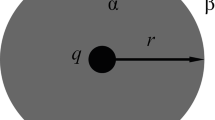Abstract
A hypothesis of mechanochemical instability of water (MCIW) is considered. It assumes that under ordinary conditions weak hydrogen bonds in water form Н2О clusters so strong that the flows with a velocity gradient can break covalent Н—ОН bonds in these clusters, which results in occurrence of Н• and ОН• radicals and formation of Н2О2 and Н2 molecules. This is a pure structural effect; therefore, the substances that strengthen the water structure (MgSO4 salt, inert gases) considerably contribute to its enhancement. An increase in temperature and/or pressure diminishes the effect, weakening the water structure and determining limits of MCIW applicability. It is assumed that the MCIW mechanism can be an important element of the global hydrogen peroxide flow on the Earth. Applications of MCIW to sonolysis, mechanical activation, and formation of active water microdroplets are demonstrated.



Similar content being viewed by others
REFERENCES
M. A. Margulis, “Sonoluminescence,” Phys.-Usp. 43 (3), 259–282 (2000). https://doi.org/10.1070/PU2000v043n03ABEH000455
V. I. Bruskov, Z. K. Masalimov, and A. V. Chernikov, “Heat-induced generation of reactive oxygen species in water,” Dokl. Biochem. Biophys.384 (6), 181–184 (2002). https://doi.org/10.1023/A:1016036617585
S. V. Gudkov, G. A. Lyakhov, V. I. Pustovoy, and I. A. Shcherbakov, “Influence of mechanical effects on the hydrogen peroxide concentration in aqueous solutions,” Phys. Wave Phenom. 27 (2), 141–143 (2019). https://doi.org/10.3103/S1541308X19020092
Jae Kyoo Lee, K. L. Walker, Hyun Soo Han, Jooyoun Kang, F. B. Prinz, R. M. Waymouth, Hong Gil Nam, and R. N. Zare, “Spontaneous generation of hydrogen peroxide from aqueous microdroplets,” Proc. Natl. Acad. Sci. U.S.A.116 (39), 19294–19298 (2019). https://doi.org/10.1073/pnas.1911883116
G. A. Lyakhov and I. A. Shcherbakov, “Approaches to the physical mechanisms and theories of low-concentration effects in aqueous solutions,” Phys. Wave Phenom. 27 (2), 79–86 (2019). https://doi.org/10.3103/S1541308X19020018
G. A. Domrachev, Yu. L. Rodygin, and D. A. Selivanovskii, “The role of sound and of liquid water as a dynamically unstable polymeric system in mechanochemically activated oxygen-generating processes under terrestrial conditions,” Russ. J. Phys. Chem. 66 (3), 457–460 (1992).
G. A. Domrachev, Yu. L. Rodygin, and D. A. Selivanovskii, “Mechanochemically activated decomposition of water in the liquid phase,” Dokl. Akad. Nauk SSSR. 329 (2), 186–188 (1993) [in Russian].
G. A. Domrachev, A. V. Mayorova, Yu. L. Rodygin, and D. A. Selivanovskii, “Sound attenuation during water sonolysis,” Acoust. Phys. 39 (2), 136–140 (1993).
G. A. Domrachev, D. A. Selivanovskii, Yu. L. Rodygin, and I. N. Didenkulov, “Sound energy losses during water sonolysis,” Russ. J. Phys. Chem. A.72 (2), 282–287 (1998).
Yu. S. Veselov, “Effect of hydrogen peroxide accumulation during reverse-osmotic desalination of sea water,” J. Water Chem. Technol. 13 (8), 741–745 (1991) [in Russian].
G. A. Domrachev, D. A. Selivanovskii, I. N. Didenkulov, Yu. L. Rodygin, and P. A. Stunzhas, “Thermal characteristics of the sonolysis efficiency and the sonoluminescence intensity in water,” Russ. J. Phys. Chem. A.75 (2), 315–320 (2001).
G. A. Domrachev, Yu. L. Rodygin, and D. A. Selivanovskii, “Improved technique for chemiluminescent determination of small concentrations of H2O2 in water,” High-Purity Subst. No. 5, 187–189 (1991) [in Russian].
G. A. Domrachev, I. N. Didenkulov, Yu. L. Rodygin, D. A. Selivanovskii, and P. A. Stunzhas, “The dissociation of water in streams near solid walls,” Chem. Phys. Rep. 20 (4), 82–89 (2001) [in Russian].
D. A. Selivanovskii, “On the effect of inert gases and air on water dissociation,” Dyn. Contin. Media. No.126, 105–106 (2010) [in Russian].
D. A. Selivanovskii, I. N. Didenkulov, G. A. Domrachev, and P. A. Stunzhas, “Mechanochemical decomposition of water as a source of oxygen in the atmosphere,” in Proceedings of the 3rd All-Russian Conference “Physical Problems of Ecology (Ecological Physics)” (May 22–24,2001, Moscow, Russia), Ed. by V. I. Trukhin, Yu. A. Pirogov, and K. V. Pokazeev (Moscow Gos. Univ., Moscow, 2001). No. 8, pp. 54–59 [in Russian]. http://ocean.phys.msu.ru/ecophys/ecophys-8.pdf
A. I. Kloss, “Electron-radical dissociation and water activation mechanism,” Dokl. Akad. Nauk SSSR. 303 (6), 1403–1407 (1988) [in Russian].
S. M. Kathmann, I.-F. W. Kuo, and C. J. Mundy, “Electronic effects on the surface potential at the vapor–liquid interface of water,” J. Am. Chem. Soc. 130 (49), 16556–16561 (2008). https://doi.org/10.1021/ja802851w
S. M. Kathmann, I.-F. W. Kuo, and C. J. Mundy, “Erratum to: “Electronic effects on the surface potential at the vapor–liquid interface of water,” J. Am. Chem. Soc. 131 (47), 17522 (2009). https://doi.org/10.1021/ja908142d
Funding
The work was performed at the Institute of Oceanology, Russian Academy of Sciences, within State Assignment no. 0149-2019-0008.
Author information
Authors and Affiliations
Corresponding author
Additional information
Translated by M. Potapov
About this article
Cite this article
Stunzhas, P.A. Mechanochemical Instability of Water and Its Applications. Phys. Wave Phen. 28, 111–115 (2020). https://doi.org/10.3103/S1541308X20020168
Received:
Revised:
Accepted:
Published:
Issue Date:
DOI: https://doi.org/10.3103/S1541308X20020168




